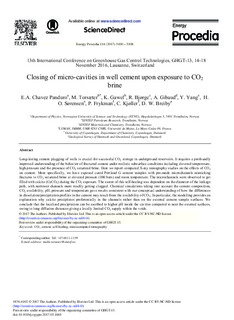| dc.contributor.author | Chavez Panduro, Elvia Anabela | |
| dc.contributor.author | Torsæter, Malin | |
| dc.contributor.author | Gawel, Kamila | |
| dc.contributor.author | Bjørge, Ruben | |
| dc.contributor.author | Gibaud, Alain | |
| dc.contributor.author | Yang, Yi | |
| dc.contributor.author | Sørensen, Henning | |
| dc.contributor.author | Frykman, Peter | |
| dc.contributor.author | Kjøller, Claus | |
| dc.contributor.author | Breiby, Dag Werner | |
| dc.date.accessioned | 2017-08-22T11:31:48Z | |
| dc.date.available | 2017-08-22T11:31:48Z | |
| dc.date.created | 2017-08-19T17:48:55Z | |
| dc.date.issued | 2017 | |
| dc.identifier.citation | Energy Procedia. 2017, 114 5100-5108. | nb_NO |
| dc.identifier.issn | 1876-6102 | |
| dc.identifier.uri | http://hdl.handle.net/11250/2451452 | |
| dc.description.abstract | Long-lasting cement plugging of wells is crucial for successful CO2 storage in underground reservoirs. It requires a profoundly improved understanding of the behavior of fractured cement under realistic subsurface conditions including elevated temperature, high pressure and the presence of CO2 saturated brine. Here we report computed X-ray tomography studies on the effects of CO2 on cement. More specifically, we have exposed cured Portland G cement samples with pre-made microchannels mimicking fractures to CO2 saturated brine at elevated pressure (100 bars) and room temperature. The microchannels were observed to get filled with calcite (CaCO3) during the CO2 exposure. The extent of this self-healing was dependent on the diameter of the leakage path, with narrower channels more readily getting clogged. Chemical simulations taking into account the cement composition, CO2 availability, pH, pressure and temperature gave results consistent with our conceptual understanding of how the differences in dissolution/precipitation profiles in the cement may result from the availability of CO2. In particular, the modelling provides an explanation why calcite precipitates preferentially in the channels rather than on the external cement sample surfaces. We conclude that the localized precipitation can be ascribed to higher pH inside the cavities compared to near the external surfaces, owing to long diffusion distances giving a locally limited CO2 supply within the voids. | nb_NO |
| dc.language.iso | eng | nb_NO |
| dc.publisher | Elsevier | nb_NO |
| dc.relation.uri | http://www.sciencedirect.com/science/article/pii/S1876610217318660 | |
| dc.rights | Attribution-NonCommercial-NoDerivatives 4.0 Internasjonal | * |
| dc.rights.uri | http://creativecommons.org/licenses/by-nc-nd/4.0/deed.no | * |
| dc.title | Closing of Micro-cavities in Well Cement upon Exposure to CO2 Brine | nb_NO |
| dc.type | Journal article | nb_NO |
| dc.type | Peer reviewed | nb_NO |
| dc.description.version | publishedVersion | nb_NO |
| dc.source.pagenumber | 5100-5108 | nb_NO |
| dc.source.volume | 114 | nb_NO |
| dc.source.journal | Energy Procedia | nb_NO |
| dc.identifier.doi | 10.1016/j.egypro.2017.03.1665 | |
| dc.identifier.cristin | 1487407 | |
| dc.relation.project | Norges forskningsråd: 243765 | nb_NO |
| dc.relation.project | Norges forskningsråd: 193816 | nb_NO |
| dc.relation.project | EC/H2020/653241 | nb_NO |
| dc.relation.project | Norges forskningsråd: 221860 | nb_NO |
| dc.description.localcode | © 2017 The Authors. Published by Elsevier Ltd. This is an open access article under the CC BY-NC-ND license (http://creativecommons.org/licenses/by-nc-nd/4.0/) | nb_NO |
| cristin.unitcode | 194,66,20,0 | |
| cristin.unitname | Institutt for fysikk | |
| cristin.ispublished | true | |
| cristin.fulltext | original | |
| cristin.qualitycode | 1 | |

